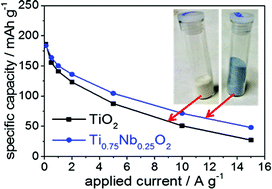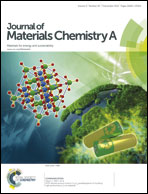Highly pseudocapacitive Nb-doped TiO2 high power anodes for lithium-ion batteries†
Abstract
Nb-doped TiO2 (anatase) nanoparticles were synthesized using a continuous hydrothermal flow synthesis reactor using a supercritical water flow as a reagent and crystallizing medium. The as-prepared nano-powders with ca. 25 at% Nb5+ (<6 nm diameter) were used as possible anodes for lithium-ion batteries without any further heat-treatment. Cyclic voltammetry and galvanostatic charge/discharge cycling tests were performed in the range of 1.2 to 3.0 V vs. Li/Li+. The Nb-doped TiO2 samples showed superior capacity retention at high current rates compared to the corresponding undoped nano-TiO2. The superior performance of the doped samples (at specific currents up to 15 A g−1) was attributed to higher electronic conductivity and a greater charge storage contribution from surface effects like pseudocapacitance (Faradaic processes) as well as Helmholtz double layer charge storage.


 Please wait while we load your content...
Please wait while we load your content...